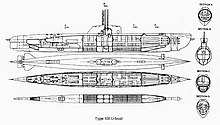
A submarine is a watercraft capable of independent operation underwater. It differs from a submersible, which has more limited underwater capability. The term is also sometimes used historically or colloquially to refer to remotely operated vehicles and robots, as well as medium-sized or smaller vessels, such as the midget submarine and the wet sub. Submarines are referred to as boats rather than ships irrespective of their size.

Alvin (DSV-2) is a crewed deep-ocean research submersible owned by the United States Navy and operated by the Woods Hole Oceanographic Institution (WHOI) of Woods Hole, Massachusetts. The original vehicle was built by General Mills' Electronics Group in Minneapolis, Minnesota. Named to honor the prime mover and creative inspiration for the vehicle, Allyn Vine, Alvin was commissioned on June 5, 1964.

The Alfa class, Soviet designation Project 705 Lira, was a class of nuclear-powered attack submarines in service with the Soviet Navy from 1971 into the early 1990s, with one serving later with the Russian Navy until 1996. They were among the fastest military submarines ever built, with only the prototype submarine K-222 exceeding them in submerged speed.

An underwater environment is a environment of, and immersed in, liquid water in a natural or artificial feature, such as an ocean, sea, lake, pond, reservoir, river, canal, or aquifer. Some characteristics of the underwater environment are universal, but many depend on the local situation.

A submersible is an underwater vehicle which needs to be transported and supported by a larger watercraft or platform. This distinguishes submersibles from submarines, which are self-supporting and capable of prolonged independent operation at sea.

A deep-submergence vehicle (DSV) is a deep-diving crewed submersible that is self-propelled. Several navies operate vehicles that can be accurately described as DSVs. DSVs are commonly divided into two types: research DSVs, which are used for exploration and surveying, and DSRVs, which are intended to be used for rescuing the crew of a sunken navy submarine, clandestine (espionage) missions, or both. DSRVs are equipped with docking chambers to allow personnel ingress and egress via a manhole.

The SP-350 Denise, famous as the "Diving saucer", is a small submarine designed to hold two people, and is capable of exploring depths of up to 400 metres (1,300 ft). It was invented by Jacques-Yves Cousteau and engineer Jean Mollard at the French Centre for Undersea Research. It was built in the year 1959 and usually operated from Cousteau's ship, the Calypso.

A diving chamber is a vessel for human occupation, which may have an entrance that can be sealed to hold an internal pressure significantly higher than ambient pressure, a pressurised gas system to control the internal pressure, and a supply of breathing gas for the occupants.

Mir was a class of two self-propelled deep-submergence vehicles. The project was initially developed by the USSR Academy of Sciences along with Lazurit Central Design Bureau, and two vehicles were ordered from Finland. The Mir-1 and Mir-2, delivered in 1987, were designed and built by the Finnish company Rauma-Repola's Oceanics subsidiary. The project was carried out under the supervision of constructors and engineers of the Shirshov Institute of Oceanology.

The Advanced SEAL Delivery System (ASDS) was a midget submarine operated by the United States Navy and United States Special Operations Command. It provided stealthy submerged transportation for United States Navy SEALs from the decks of nuclear submarines for use as an insertion platform for covert and clandestine special operations missions. The ASDS was canceled in 2009 due to cost overruns and reliability issues, after the prototype was destroyed in a fire in 2008. As of 2019, the Navy plans to replace the ASDS with the Dry Combat Submersible, a similar midget submarine being developed by Lockheed Martin.
Depth ratings are primary design parameters and measures of a submarine's ability to operate underwater. The depths to which submarines can dive are limited by the strengths of their hulls.
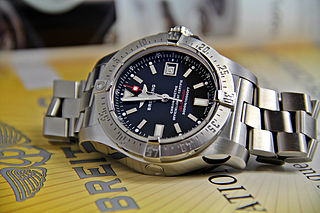
A diving watch, also commonly referred to as a diver's or dive watch, is a watch designed for underwater diving that features, as a minimum, a water resistance greater than 1.1 MPa (11 atm), the equivalent of 100 m (330 ft). The typical diver's watch will have a water resistance of around 200 to 300 m, though modern technology allows the creation of diving watches that can go much deeper. A true contemporary diver's watch is in accordance with the ISO 6425 standard, which defines test standards and features for watches suitable for diving with underwater breathing apparatus in depths of 100 m (330 ft) or more. Watches conforming to ISO 6425 are marked with the word DIVER'S to distinguish ISO 6425 conformant diving watches from watches that might not be suitable for actual scuba diving.
A teardrop hull is a submarine hull design which emphasizes submerged performance over surfaced performance. It was somewhat commonly used in the early stages of submarine development, but was gradually abandoned in the early 20th century in favour of designs optimized for high performance on the surface as a result of changes in operational doctrine. Although naval doctrine changed, design practices remained until the later parts of World War II when the German Kriegsmarine suffered ever-growing losses of submarines in the Battle of the Atlantic.
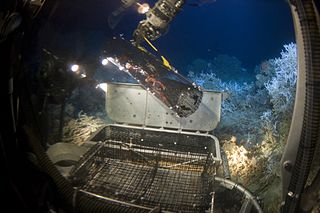
Deep-sea exploration is the investigation of physical, chemical, and biological conditions on the ocean waters and sea bed beyond the continental shelf, for scientific or commercial purposes. Deep-sea exploration is an aspect of underwater exploration and is considered a relatively recent human activity compared to the other areas of geophysical research, as the deeper depths of the sea have been investigated only during comparatively recent years. The ocean depths still remain a largely unexplored part of the Earth, and form a relatively undiscovered domain.

Ictíneo I was a pioneering submarine constructed in Barcelona, Spain in 1858–1859 by engineer Narcís Monturiol.

The Shinkai (しんかい) was a crewed research submersible that could dive up to a depth of 600 m. It was completed in 1970, and until 1981 it had the greatest depth range of any crewed research vehicle in Japan. The Shinkai is owned and run by the Japan Coast Guard and it is launched from the support vessel Otomemaru (乙女丸).
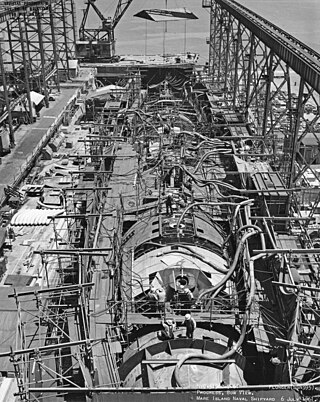
HY-80 is a high-tensile, high yield strength, low alloy steel. It was developed for use in naval applications, specifically the development of pressure hulls for the US nuclear submarine program and is still currently used in many naval applications. It is valued for its strength to weight ratio.

The Shinkai 2000 (しんかい) was a crewed research submersible that could dive up to a depth of 2,000 meters. It was completed in 1981 and until 1991 it had the greatest depth range of any crewed research vehicle in Japan. The Shinkai 2000 was owned and run by the Japan Agency for Marine-Earth Science and Technology (JAMSTEC) and it was launched from the support vessel Natsushima.
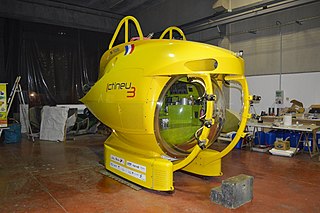
Ictineu 3 is a crewed submersible capable of reaching depths of 1,200 m (3,900 ft), which makes it the ninth deepest submersible, owned by Ictineu submarins SL. Commissioned in 2013, the submersible can carry one pilot and two passengers for 10 hours using all the equipment.

Limiting Factor, known as Bakunawa since its sale in 2022, is a crewed deep-submergence vehicle (DSV) manufactured by Triton Submarines and owned and operated since 2022 by Gabe Newell’s Inkfish ocean-exploration research organization. It currently holds the records for the deepest crewed dives in all five oceans. Limiting Factor was commissioned by Victor Vescovo for $37 million and operated by his marine research organization, Caladan Oceanic, between 2018-2022. It is commercially certified by DNV for dives to full ocean depth, and is operated by a pilot, with facilities for an observer.

